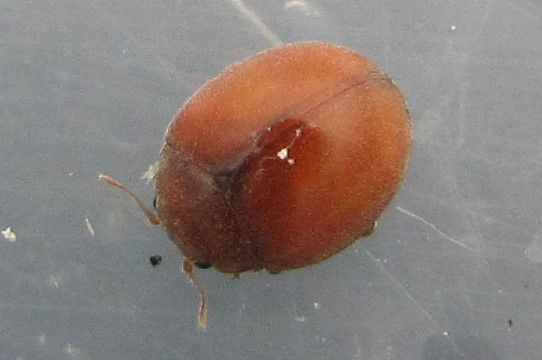Antennae Shapes
Insects have a variety of antennae shapes and forms. The ladybirds have clubbed antennae, similar to the familiar antennae of butterflies

Large Skipper showing familiar clubbed antennae typical of butterfly species
Ladybird antennae have smaller clubbed ends than most butterflies but the shape is still distinctive. A thin thread like section with even sized segments when viewed under magnification and a clubbed thicker section at the end formed by the last three segments.

22-spot Ladybird with antennae slightly longer than head width
Ladybirds hold their antennae in a distinctive fashion. Most of the time the antennae are held to the side , rather than forward. There is usually a kink at the halfway point. These two features combine to resemble the shape of a metal coat hanger.

7-spot Ladybird with antennae about the length of head width

Adonis Ladybird

10-spot Ladybird

2-spot Ladybird

16-spot Ladybird

Striped Ladybird showing smooth curve to antennae

Larch Ladybird holding antennae to the front but still showing distinctive kink

The unspotted form of 24-spot Ladybird can cause confusion but the antennae again help identification

Kidney-spot Ladybird has very short clubbed antennae typical of the tribe Chilocorini
When seen for the first time it is not immediately obvious why the inconspicuous ladybirds are related to the conspicuous ladybirds.
However, when looking at the antennae the close relationship becomes apparent.
The Tribe Coccidulini has long antennae, usually longer than head width.
The shape is still the same, held to the side with a kink at the half way point.

Red Marsh Ladybird with typical coat hanger shape to long antennae

Spotted Marsh Ladybird

Forestier's Ladybird showing typically shaped ladybird antennae

Bristly Ladybird
The Tribe Scymnini has much shorter antennae but they are still clubbed and held to the side.

Red-flanked Ladybird with very short clubbed antennae held to the side

Conifer Ladybird: Not obviously a ladybird until the antennae are examined

Red-rumped Ladybird

Ivy Ladybird
When searching for ladybird images on the internet, there are many images of dead pinned specimens from collections that have the antennae held out straight and towards the front. This is not typical of how live specimens of ladybird look in the field but is more typical of other beetle groups, some of which can be confused with ladybirds.
When viewed or photographed from behind the antennae of some inconspicuous ladybirds can appear straight but this is at least partly due to perspective.

Meadow Ladybird showing straight antennae when viewed from behind
When disturbed Arboreal Ladybird often sits tight with its legs and antennae held out of sight. They need to be left to start walking about before the antennae can be examined.

Arboreal Ladybird with antennae tucked out of sight
The False Ladybird is a species of handsome fungus beetle that is easily confused with a ladybird as it is red with four black spots. The antennae are the easiest way to avoid confusion. They are unclubbed, long and held out to the front, usually with a 90 degree angle between them.

False Ladybird Endomychus coccineus with long, straight and unclubbed antennae held towards the front.
The leaf beetles Chrysomelidae are a large family of beetles that often resemble ladybirds.
The antennae are unclubbed and held straight and towards the front and often at a right angle to each other.

Rosemary Beetle Chrysolina americana showing typical Leaf Beetle antennae

Gonioctena decemnotata with ladybird like colouring and similar antennae, although lacking clubbed ends.

Sphaeroderma testaceum resembling a ladybird but very long antennae immediately obvious.

Galerucella species
_JPG.jpg)
Unidentified beetle swept from dry grassland
Similar colour and size to Meadow Ladybird
The long straight unclubbed antennae rule it out as a ladybird

Unidentified beetle swept from wet grassland
Similar colour, shape and size to Red Marsh Ladybird
The long straight unclubbed antennae rule it out as a ladybird
The shining flower beetles Olibrus are easily confused with inconspicuous ladybirds.
Their antennae are also clubbed and held with a kink at the half way point.
The clubs are proportionally a little larger.
Also the body shape is widest towards the front rather than half way and as the family name suggests they are shiny and hairless.
As they can be common whilst sweep netting grassland, it is worth learning how to recognise this group.

All dark Olibrus resembling a Scymnus species, although the antennae length is longer

Olibrus species resembling Red-rumped Ladybird
Again the antennae are to long for this species
The pollen beetles Nitidulidae can be found in large numbers and are small with clubbed antennae. The antennae have large clubbed ends and the body shape is more rectangular than a typical Scymnus species.

Pollen Beetle Meligethes

Glischrochilus hortensis Another black beetle with red spots and clubbed antennae but the body shape unlike any ladybird
When a suspected ladybird is found a combination of body shape and antennae type is the first step in ruling out lookalike beetle species which can complicate the identification process.